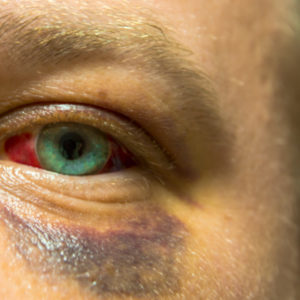
According to the CDC roughly 2,000 workers per day sustain ocular trauma. This statistic does not account for accidents, assault and various activities that may result in damage or injury to the eyes. It is important that we recommend protective eyewear for our patients whenever possible. While optometrists are not always the first doctors on site for ocular injuries, you do stand a good chance of having a patient with a recent ocular trauma in your chair. Here are some of the basics in dealing with an ocular trauma “emergency” patient.
- Do not panic: Your patient is probably panicked enough for the both of you. And even if your patient is calm, he or she will begin to worry if they sense your anxiety.
- Take a good case history: A solid case history is always important. It is especially important with emergencies because it steers you towards a tentative diagnosis and/or strong list of differentials, which allows you to focus your exam with problem based testing. Some key case history elements for trauma related emergencies include finding out how the patient was hurt as well as obtaining a list of ocular and systemic conditions, medications, and allergies.
- Take VAs: This largely to establish a baseline for treatment and legal purposes. Unless your patient has suffered a chemical burn, you must take visual acuities before you do anything else. If your patient is in a lot of pain, consider looking at the anterior segment and, if safe, administering an anesthetic drop to help the patient feel more comfortable. Remember to document your steps as good record keeping will be helpful for any referrals as well as protect you in case of a potential lawsuit.
During your exam, pay careful attention to pupil responses (is there an APD?), EOMs (is there pain or diplopia?), external exam/slit lamp (is there a corneal abrasion, foreign body, hyphema, cells/flare?), tonometry, and DFE (any holes/breaks/tears?).
- Triage: Not all “emergency” ocular trauma cases are true emergencies, though all will benefit from prompt care. While true ocular emergencies require a referral to the ER or ophthalmology, some cases of trauma may be treated in your chair depending on laws of the state where you practice. For instance, a small corneal abrasion, while painful, is not a true emergency and can potentially be managed with artificial tears and a prophylactic antibiotic. Meanwhile, if you suspect globe rupture, this is a true ocular emergency. You should avoid manipulating the eye, shield the eye with a rigid eye shield to prevent further damage to the eye, and refer to an ophthalmologist immediately for evaluation. The rigid eye shield may be a eye protective gear (such as ballistic glasses or goggles) or the bottom of a disposable cup. Secure the shield by applying tape from the forehead to the cheek. Never instill solutions or ointments into a suspected open globe, never put pressure or a soft patch on the eye, and never remove foreign bodies protruding from the eye or orbit.
- Imaging: A CT scan is considered the standard of care if you suspect internal ocular damage for ocular trauma. Ordering a CT scan can not only help you better understand an injury, but it can also help with your referral. For instance, if you suspect globe rupture, ordering a CT scan and including that in your referral can be helpful to the next doctor who treats your patient.
- Remember the follow up: In most cases, you will want to follow up with your ocular trauma patient. It is important to stress to your patient that a follow up is necessary to evaluate progression and rule out other sequelae such as angle recession and traumatic cataracts.
Ocular traumas come in all shapes, sizes and risk levels. Handling the situation in a calm manner and keeping in mind what you already know about trauma basics can help you make accurate diagnosis and create a sound treatment plan. For specific terminology regarding trauma, check out the Birmingham Eye Trauma Terminology System (BETTS). Stay tuned for more articles about dealing with ocular trauma. Coming up next: Your Patient Got Punched in the Eye: Short Term and Long-Term Effects of Ocular Blunt Trauma.

